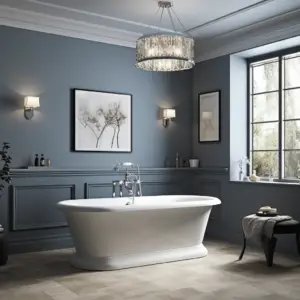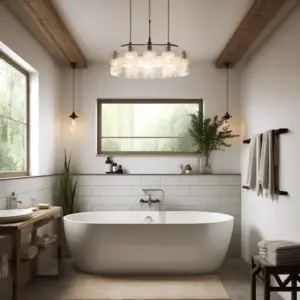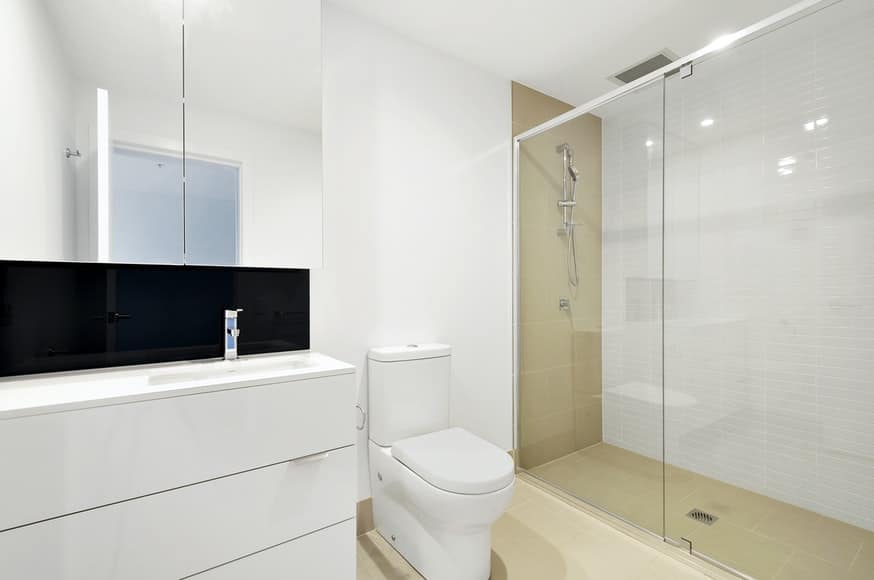Damp-Rated Lights for Your Bathroom, Yes. In this article, we’re going to peruse the damp rating of the bathroom.
A damp location could be termed to describe an interior or exterior location that is normally or periodically subject to condensation of moisture.
The main reason as to why bathrooms are considered and rated damp is because of either hot or cold water generated from the sink and shower.
The build-up of moisture within the bathroom develops in the bathtub or shower.
Areas within the bathroom are directly affected by moisture. Moisture build up rises and settles on the light bulbs; thus, it is crucial to ensure the lights can handle moisture to counter break or short out.
Damp locations require specialized zoning and lighting fixtures for overall safety against hurdles such as electrical hitches.
Bathrooms require installing damp-rated lights to save yourself from fixing lights and save your wallet from often light bulb replacement.
Varying definitions that distinguish bathroom as a damp location from a wet and dry location:
- Damp location: Partially protected location that is periodically subject to moderate degree of moisture in, on, or adjacent to electrical equipment.
- Wet location: Location in which water can drip or flow on or against electrical equipment—for example, a shower.
- Dry location: The location is not normally subjected to dampness but may be subjected to temporary dampness with adequate ventilation to prevent moisture accumulation.
Table of Contents
What is a Damp Rating?

This is a light bulb rating system that measures how much moisture lighting can absorb before faulting.
Living spaces such as bathrooms, indoor pools, covered porches, and kitchens expose light fixtures to moisture; hence they warrant a damp rating.
Damp rating is mainly carried out in spaces and rooms that boast atmospheres, for example, indoor pools and bathrooms.
It is crucial to mark and label lighting fixtures and ceiling fans ‘suitable for damp location’ so as to protect the homeowner from faulty or probable harm from moisture build-up with the electricity.
Damp location can be determined through varying IP ratings. IP65 is a rating that protects water jets at any angle. IP68 is rated for full, permanent submersion in water up to 13 feet. Lastly, IP67 is for temporary submersion in up to 3 feet of moisture for less than 30 minutes.
Why is the Bathroom Begarded As a Damp Location?
- A partially sheltered bathroom is directly affected by dampness.
- Shower water collects on the bulb, allowing humidity.
- The bathroom’s interior is occasionally condensed due to dampness.
- Bathrooms are damp-rated because water could hit the light bulb.
Do Bathroom Lights Have To Be Damp Rated?
Most bathroom areas benefit from damp-rated lights. When wiring fixtures near your shower, use dry-rated lighting.
Bathroom dry-rated lights are not necessarily for dry spots. Damp-rated lights are normally used in areas with regular moisture rather than areas with constant or direct exposure to water.
When purchasing lights for the bathroom, it is imperative to counter-check on damp rating. Purchasing damp-rated lights help in achieving a decision in which style and type of bulb to go for.
You can also buy bathroom lights depending on moisture absorption. Lights away from the shower and sink can be installed normally. Damp rated fixtures can only handle indirect exposure to moisture. Lights situated directly above a shower with no casing need to be damp rated. Most importantly, counter-check damp rating by the scale on the bottom of the bulb manual so as to learn how much moisture the bulb can handle and help the lifespan of the light bulb.
A Bathroom As a Dry Location
Bathrooms with temporary dampness and adequate ventilation can be categorized to dry locations. The nature of the bathroom could necessitate it to be termed as a dry location, just like most finished indoor areas. Such rooms don’t require a damp location rating.
Commonly Preferred Damp-rated Lights For Bathrooms

LED Lights: They are some of the highly recommended lights because they are star-listed and are UL certified. Users can customize LED lights by dimming from 10% to 100%. The damp rated LED lights allow easy installation on areas where dampening may occur.
Light-emitting diode bulbs are viable options for bathroom lighting.
Torchstar: These options entail a traditional light bulb feel. It is a damp-rated bulb built to last under damp conditions.
The 15W light bulb is built to last as it incorporates resistance features to vibration impacts. Get one of these Torchstar lightbulbs, especially for bathrooms with kids constantly slamming doors in the house.
Honeywell All-in-One: This is an All-In-one solution fan and light bulb with waterproof and damp rated features. It comes with a ceiling fan that is great for damp weather conditions and heat distribution across the room during winter.
FAQ’s For Bathrooms Considered to be Damp Location
- Can you put a chandelier in the bathroom?
A chandelier works best in bathrooms with high or vaulted ceilings; hence you need overhead space to hang a chandelier. This ensures the light fixture is not too close to the tub, and you won’t bump on it.
- Can you put a lamp in the bathroom?
The best way to incorporate lamps into the bathroom is by combining the bulbs with the ceiling. This allows easy hanging of the lamp in the middle of the room window.
- Do you need special fittings for bathrooms?
Light fittings marked as fit for the bathroom can be used along zone 2. Place the fittings 0.6 meters outside the bath and above the bath.
That’s a wrap! We hope the article was helpful, but don’t hesitate to ask or comment if you have any more queries.
Conclusion
Bathrooms could be considered damp locations due to the build-up of moisture over some time. Installation of damp-rated lights in bathrooms or areas that may receive moisture over time helps counter faulty occurrences.


